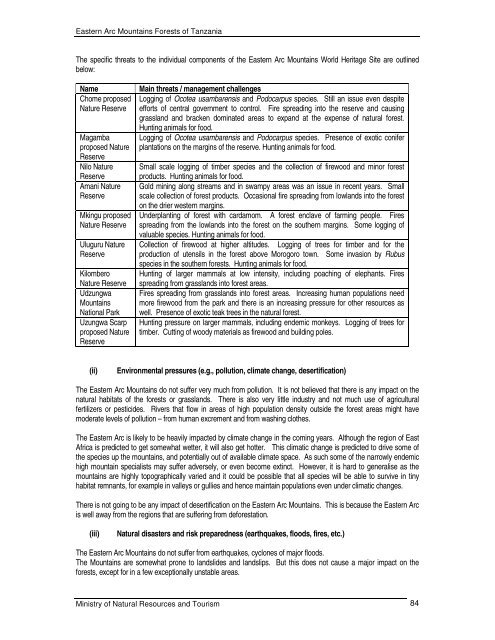eastern arc mountains forests of tanzania - Campaign for the ...
eastern arc mountains forests of tanzania - Campaign for the ...
eastern arc mountains forests of tanzania - Campaign for the ...
You also want an ePaper? Increase the reach of your titles
YUMPU automatically turns print PDFs into web optimized ePapers that Google loves.
Eastern Arc Mountains Forests <strong>of</strong> Tanzania<br />
The specific threats to <strong>the</strong> individual components <strong>of</strong> <strong>the</strong> Eastern Arc Mountains World Heritage Site are outlined<br />
below:<br />
Name Main threats / management challenges<br />
Chome proposed<br />
Nature Reserve<br />
Magamba<br />
proposed Nature<br />
Reserve<br />
Nilo Nature<br />
Reserve<br />
Amani Nature<br />
Reserve<br />
Mkingu proposed<br />
Nature Reserve<br />
Uluguru Nature<br />
Reserve<br />
Kilombero<br />
Nature Reserve<br />
Udzungwa<br />
Mountains<br />
National Park<br />
Uzungwa Scarp<br />
proposed Nature<br />
Reserve<br />
Logging <strong>of</strong> Ocotea usambarensis and Podocarpus species. Still an issue even despite<br />
ef<strong>for</strong>ts <strong>of</strong> central government to control. Fire spreading into <strong>the</strong> reserve and causing<br />
grassland and bracken dominated areas to expand at <strong>the</strong> expense <strong>of</strong> natural <strong>for</strong>est.<br />
Hunting animals <strong>for</strong> food.<br />
Logging <strong>of</strong> Ocotea usambarensis and Podocarpus species. Presence <strong>of</strong> exotic conifer<br />
plantations on <strong>the</strong> margins <strong>of</strong> <strong>the</strong> reserve. Hunting animals <strong>for</strong> food.<br />
Small scale logging <strong>of</strong> timber species and <strong>the</strong> collection <strong>of</strong> firewood and minor <strong>for</strong>est<br />
products. Hunting animals <strong>for</strong> food.<br />
Gold mining along streams and in swampy areas was an issue in recent years. Small<br />
scale collection <strong>of</strong> <strong>for</strong>est products. Occasional fire spreading from lowlands into <strong>the</strong> <strong>for</strong>est<br />
on <strong>the</strong> drier western margins.<br />
Underplanting <strong>of</strong> <strong>for</strong>est with cardamom. A <strong>for</strong>est enclave <strong>of</strong> farming people. Fires<br />
spreading from <strong>the</strong> lowlands into <strong>the</strong> <strong>for</strong>est on <strong>the</strong> sou<strong>the</strong>rn margins. Some logging <strong>of</strong><br />
valuable species. Hunting animals <strong>for</strong> food.<br />
Collection <strong>of</strong> firewood at higher altitudes. Logging <strong>of</strong> trees <strong>for</strong> timber and <strong>for</strong> <strong>the</strong><br />
production <strong>of</strong> utensils in <strong>the</strong> <strong>for</strong>est above Morogoro town. Some invasion by Rubus<br />
species in <strong>the</strong> sou<strong>the</strong>rn <strong><strong>for</strong>ests</strong>. Hunting animals <strong>for</strong> food.<br />
Hunting <strong>of</strong> larger mammals at low intensity, including poaching <strong>of</strong> elephants. Fires<br />
spreading from grasslands into <strong>for</strong>est areas.<br />
Fires spreading from grasslands into <strong>for</strong>est areas. Increasing human populations need<br />
more firewood from <strong>the</strong> park and <strong>the</strong>re is an increasing pressure <strong>for</strong> o<strong>the</strong>r resources as<br />
well. Presence <strong>of</strong> exotic teak trees in <strong>the</strong> natural <strong>for</strong>est.<br />
Hunting pressure on larger mammals, including endemic monkeys. Logging <strong>of</strong> trees <strong>for</strong><br />
timber. Cutting <strong>of</strong> woody materials as firewood and building poles.<br />
(ii) Environmental pressures (e.g., pollution, climate change, desertification)<br />
The Eastern Arc Mountains do not suffer very much from pollution. It is not believed that <strong>the</strong>re is any impact on <strong>the</strong><br />
natural habitats <strong>of</strong> <strong>the</strong> <strong><strong>for</strong>ests</strong> or grasslands. There is also very little industry and not much use <strong>of</strong> agricultural<br />
fertilizers or pesticides. Rivers that flow in areas <strong>of</strong> high population density outside <strong>the</strong> <strong>for</strong>est areas might have<br />
moderate levels <strong>of</strong> pollution – from human excrement and from washing clo<strong>the</strong>s.<br />
The Eastern Arc is likely to be heavily impacted by climate change in <strong>the</strong> coming years. Although <strong>the</strong> region <strong>of</strong> East<br />
Africa is predicted to get somewhat wetter, it will also get hotter. This climatic change is predicted to drive some <strong>of</strong><br />
<strong>the</strong> species up <strong>the</strong> <strong>mountains</strong>, and potentially out <strong>of</strong> available climate space. As such some <strong>of</strong> <strong>the</strong> narrowly endemic<br />
high mountain specialists may suffer adversely, or even become extinct. However, it is hard to generalise as <strong>the</strong><br />
<strong>mountains</strong> are highly topographically varied and it could be possible that all species will be able to survive in tiny<br />
habitat remnants, <strong>for</strong> example in valleys or gullies and hence maintain populations even under climatic changes.<br />
There is not going to be any impact <strong>of</strong> desertification on <strong>the</strong> Eastern Arc Mountains. This is because <strong>the</strong> Eastern Arc<br />
is well away from <strong>the</strong> regions that are suffering from de<strong>for</strong>estation.<br />
(iii) Natural disasters and risk preparedness (earthquakes, floods, fires, etc.)<br />
The Eastern Arc Mountains do not suffer from earthquakes, cyclones <strong>of</strong> major floods.<br />
The Mountains are somewhat prone to landslides and landslips. But this does not cause a major impact on <strong>the</strong><br />
<strong><strong>for</strong>ests</strong>, except <strong>for</strong> in a few exceptionally unstable areas.<br />
Ministry <strong>of</strong> Natural Resources and Tourism 84


